
views
- Use a dry lubricant like graphite powder or Teflon-based (PTFE) lubricants to lubricate your locks. These are long-lasting, repel dirt, and prevent corrosion.
- Or, opt for a silicone or grease lubricant. These are long-lasting and resistant to moisture, though they tend to attract more dirt than other lubricants.
- Lube your locks about 2-4 times per year. Apply the lubricant into the keyhole and then repeatedly insert the key into the lock to disperse the lube.
The Best Lock Lubricants
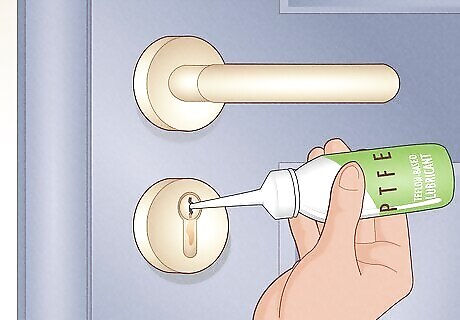
Teflon-based (PTFE) lubricants Teflon-based lubricants are made with polytetrafluoroethylene (PTFE) to lubricate your locks while resisting moisture and dirt buildup. Most Teflon-based lubricants are aerosols, so simply insert the nozzle of the can into the lock and spray several squirts. Then, insert the key back and forth in the lock to spread the lubricant. Pros: The non-stick formula of Teflon-based lubricants repels dirt and dust for a long time. This lubricant also works in moist and freezing environments, as it’s water resistant, and in hot temperatures. Cons: Applying Teflon-based lubricants can get messy. Teflon-based lubricants also come in a dry formula.
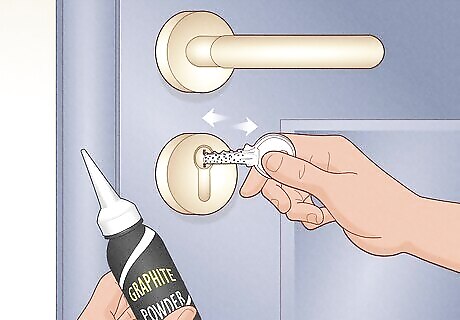
Graphite powder lubricants Graphite powder is a popular dry lubricant that repels dirt and dust to keep your lock clean and in working condition. To use graphite powder, simply squeeze the lubricant into the lock. Then, repeatedly insert the key and twist it around to disperse the lubricant through the lock. Pros: Graphite powder is long-lasting and isn’t sticky or oily, so it keeps dust, dirt, and debris away. It also helps prevent rust and works well in high and low temperatures. Cons: Master locksmith Shawn Fago warns that with frequent use, graphite “builds up inside [the lock]...because graphite is a powder.” In wet and humid climates, it can harden and jam up the locking mechanisms. Graphite lubricants come in both powdered and liquid forms.
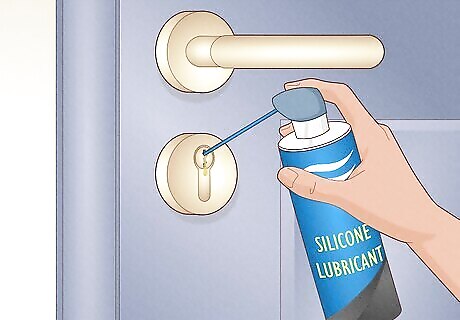
Silicone lubricants Silicone lubricants are made with silicone, which is great at repelling water and dirt and preventing your locks from corroding. Silicone lubricants typically come in aerosol cans, so just place the nozzle inside your lock and give it a few sprays. Then, work your key into the lock a few times to disperse the lubricant. Pros: Silicone lubricants are water resistant and aren’t oil-based, so they don’t attract dust and dirt. They also stand up to extreme temperatures, making them long-lasting. Cons: Silicone lubricants can lead to more buildup compared to Teflon-based lubricants. They can also be messy and stain surfaces.
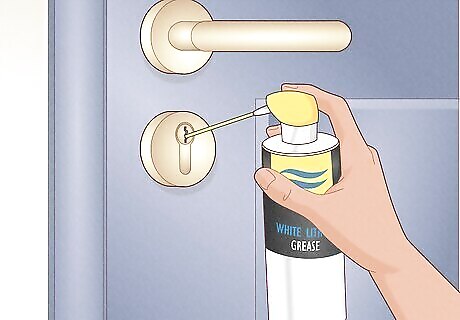
Grease lubricants Grease-based lubricants, like white lithium grease, are super water resistant to help prevent your locks from developing rust and corrosion. To use a grease lubricant, squirt several sprays into your lock. Then, push your key back and forth into the lock to distribute the lubricant. Pros: Grease lubricants create a thick, long-lasting barrier to repel water and frost. The thicker formula makes this lubricant great for large, heavy-duty locks. Cons: Grease lubricants are more prone to attracting dust and dirt. Their thick formula can also cause more delicate locks and mechanisms to stick.
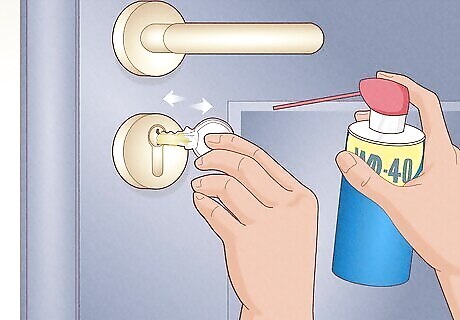
WD-40 While WD-40 is a penetrating oil and technically not a lubricant, it can get a stuck lock moving if you’re in a pinch. Simply spray WD-40 into the lock. Then, repeatedly insert your key into the keyhole to work the WD-40 into the lock. Pros: WD-40 acts as a cleaner rather than a lubricant, removing dust buildup, rust, and corrosion to get your lock working again. Cons: WD-40 is part oil, so it attracts dust and dirt that can eventually gum up your lock. It also wears away quickly, so it’s not a long-term solution.

De-icer lubricants If you live in a cold climate, de-icer lubricants help thaw frozen locks and prevent them from freezing again. Simply squeeze the de-icer lubricant in your lock, whether it’s currently frozen or not. Then, work your key back and forth in the lock to spread the lubricant. Pros: De-icer lubricants are specifically made for cold temperatures to unfreeze your lock or prevent it from freezing. Cons: De-icers can cause buildup and displace lubricants you used previously.

Pencils If you’re in a pinch, use the graphite lead in a regular pencil to lubricate your lock. Simply rub a sharpened pencil in between the grooves of your key and on its sides. Then, push the key back and forth in the lock to distribute the graphite. Just repeatedly rub the key with the pencil and work it into the lock until the lock is completely lubricated. Pros: Lubricating a lock with a pencil is a quick solution if you don’t have any other lubricants on hand. Cons: Pencils are a short-term solution, as the graphite typically wears away quickly. It also isn’t as effective as graphite powder and other lubricants.
Routine Lock Care and Maintenance

Clean your locks with compressed air or WD-40 2 times per year. Before you lubricate your locks, it’s important to clean out any dirt, dust, and rust buildup. Simply point the spray nozzle of a can of compressed air into the lock to blow out the debris about 2 to 4 times per year. Or, spray the inside of the lock with WD-40. If you’re cleaning your lock with WD-40, let the cleaner completely dry and evaporate over a few days before applying a lubricant.

Lubricate your locks 2 times per year, or when they start to stick. Regularly lubricating your house, car, and other locks helps protect their moving parts against friction and repel dirt and moisture. This keeps your locks in working order and helps extend their lifespan. Just apply the lubricant of your choice about 2 to 4 times each year, or whenever they start to get tough to open. How often you lubricate your locks depends on the environment you live in. Humid, rainy, salty, dusty, and cold climates typically need more frequent lock lubrication.
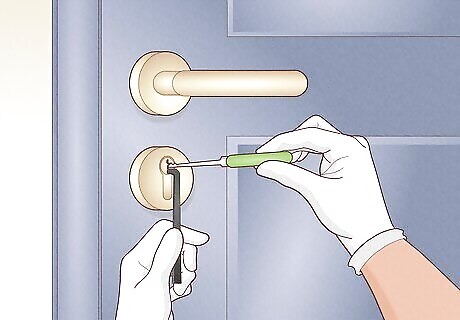
Call a locksmith if your lock still isn’t working after lubricating it. Master locksmith Shawn Fago says, “if a lock is not turning properly, you typically have different issues, such as a badly worn key or a lock that is failing with wafers that are either worn out or worn down.” He recommends getting your lock “addressed by a locksmith” to diagnose and fix the issue. Check to make sure your key isn’t the problem before calling a locksmith. If an undamaged spare key opens the lock, your original key is likely the issue.
Deep Cleaning a Door Lock
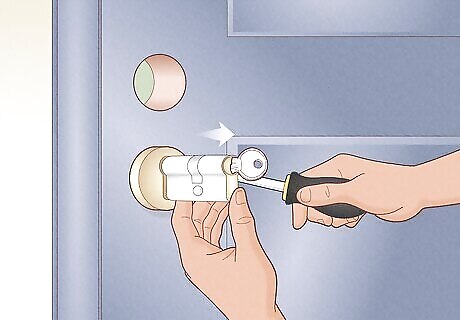
Use a screwdriver to take apart the lock. Grab a Phillips head screwdriver and unscrew the screws on the doorknob. Then, use the same screwdriver to remove the screws holding the faceplate to the side of the door. Simply pull out the doorknob, locking mechanism, faceplate, and latchbolt and place them on a sheet of newspaper or cardboard.
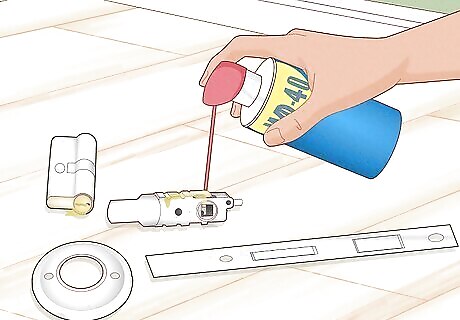
Clean each part of the lock with WD-40. Use a cleaner like WD-40 to spray inside the keyhole, locking mechanism, cylinder, doorknob, faceplate, and any other parts of the lock. Just spray each part until you flush out all of the built-up dust and dirt. Then, use a clean cloth to wipe down the parts and remove the excess cleaner.

Let the lock parts dry and then apply a lubricant, like graphite. Leave the lock to dry for 1 to 2 hours. Then, apply the lubricant of your choice to all of the moving parts of the lock. For instance, squeeze the lubricant into the keyhole, cylinder, latchbolt, doorknob, and any other pieces that move. Use a cloth to wipe up any lubricant that spills.
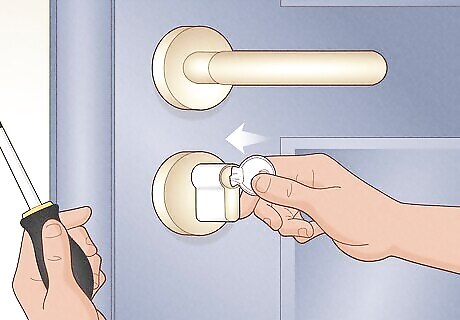
Put the lock back together and secure it to your door. Put the latchbolt and faceplate back on the side of the door and screw them in. Then, insert the outside doorknob and inside doorknob in the door and screw them in. Make sure all of the screws are tight and turn the door knob to make sure everything works smoothly.
Lubricating Nightlatches and Padlocks
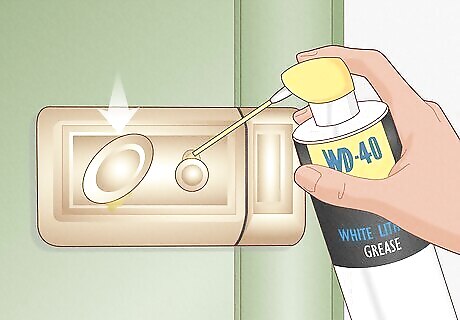
Grease the interior latch and switch. Apply a few sprays of grease-based lubricant or a few drops of oil onto the interior latch of the night latch. Then, apply the lubricant on the snip switch and to the base of the knob. Add lubricant to the sliding bolt, too.
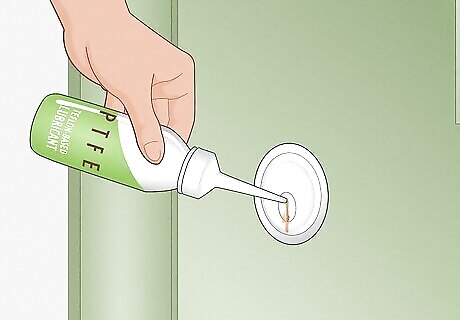
Lube the exterior of the night latch. Use a dry lubricant like Teflon-based (PTFE) lubricant or graphite powder to lube the exterior of the night latch, which helps prevent dust and grime from building up inside the locking mechanism. Apply a bit of the lubricant into the keyhole on the exterior of the night latch. Then, insert the key and turn it a few times, which helps distribute the lubricant into the locking mechanism.

Lube a padlock with Teflon-based lubricant. Spray Teflon-based (PTFE) lubricant into the keyhole on the padlock. Then, repeatedly insert the key and move it around to spread the lubricant throughout the lock. Apply a bit of lubricant into the shackle and shackle hole on the padlock, too. Gently shake or tap the padlock to help the lubricant seep into the lock.

















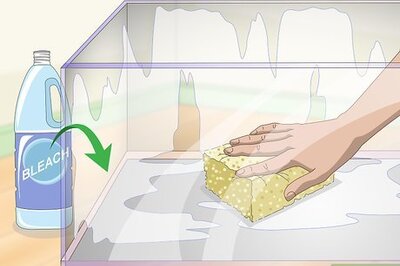
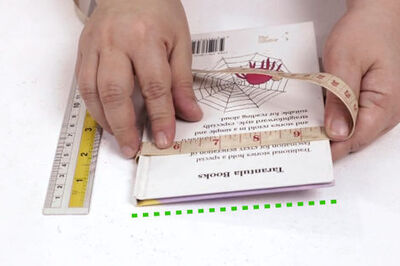
Comments
0 comment